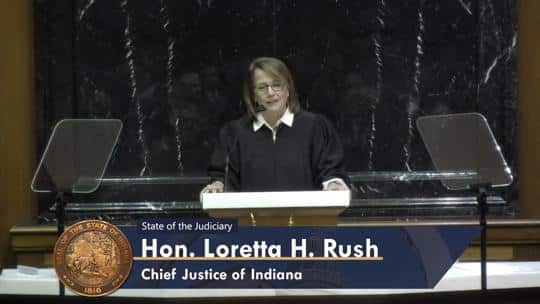
Rush said she is proud Indiana’s court system has persevered through the last few years of the coronavirus pandemic. She said the three branches of Indiana government work well together because they are all housed in the same building. That’s not the case in many other states.
“In many ways, the courts have become the government emergency room for society’s worst afflictions,” she said.
She also said she wants to make the state a place where people want to “live, work, play, study and stay,” a reference to Gov. Eric Holcomb’s 2022 legislative priorities.
The court’s four primary goals moving forward are to foster public trust, strengthen families, expand public safety and modernize the courts.
Rush welcomed Justice Steven David to brief the state on the court’s technology reforms. David will step down this year after 30 years as a judicial branch leader. He was appointed to the court in 2010.
David said the courts have now implemented a unified case management system for all 92 counties. The website mycase.in.gov is available at all times free of charge. He added that the site averages 34 million visits per year.
David also said the state uses e-filing to save paper and effort in case fillings.
“Please attend a problem-solving court graduation. You must experience it to really appreciate it. Watch the very police officer who arrested the person for drug use stand with that individual, and they hug each other in tears of triumph,” David said.
In another public service effort, David said the state hosts nearly 4,000 GAL/CASA volunteers, who advocate for children in court cases.
“We are glad to be doubling down on our public service efforts with you in 2022,” David said.
Rush said David leaves behind a sturdy legacy. With his departure, the court is looking to establish a blueprint for the future. The court’s future plans include a centralized jail management system, which would allow court officials to access data more effectively. It would also provide more accurate criminal records and allow judges to view someone’s incarceration status in real time. Finally, it would combat jail overcrowding, an issue that several legislators strive to address by participating in the Jail Overcrowding Taskforce, chaired by David.
The court is also piloting a housing court to address the state’s relatively high level of evictions, alongside the Eviction Task Force. According to Slacker, a data journalism website, Indiana’s eviction rate is the seventh highest in the nation.
Rush said Hoosiers may be able to resolve disputes online for free in the coming years. Because of increasing legal capacity on the web, appearing in court may become unnecessary in some cases.
Finally, Rush said the court is working to lighten the extent to which law enforcement is responsible for addressing people’s mental illnesses.
“Police officers are not social workers, and jails are not treatment centers,” she said. “And when we ask them to be, we compromise their core function of preserving public safety, which in turn puts everyone at risk.”
Isaac Gleitz is a reporter for TheStatehouseFile.com, a news website powered by Franklin College journalism students.